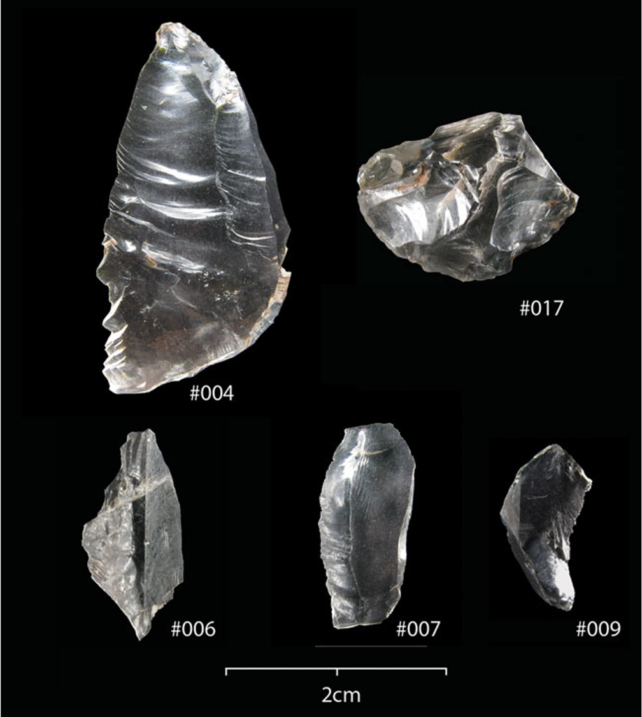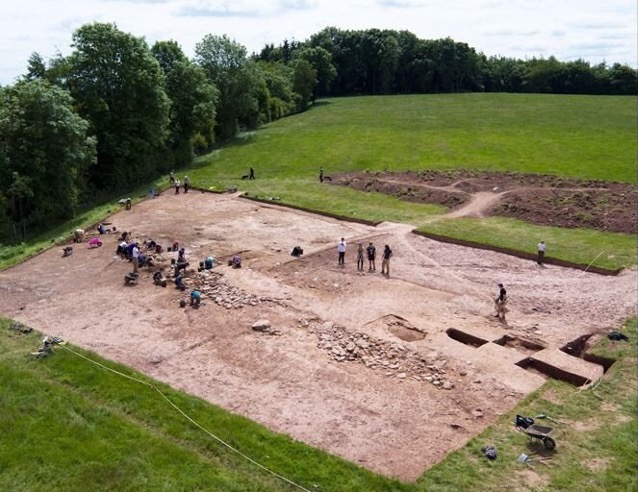Hundreds of fragments of a rare transparent type of quartz called 'rock crystal' suggest Neolithic people used the mineral to decorate graves and other structures at a ceremonial site in western England, archaeologists say.
The rock crystals were likely brought to the site from a source more than 80 miles (130 kilometers) away, over mountainous terrain, and the crystals appear to have been carefully broken into much smaller pieces, possibly during a community gathering to watch the working of what must have seemed like a magical material.
"You can think of it as a really special event," Nick Overton, an archaeologist at The University of Manchester in England, told Live Science.
"It feels like they're putting a lot of emphasis on the practice of working [the crystal] … people would have remembered it as being distinctive and different."
Overton is the lead author of a study published in July in the Cambridge Archaeological Journal that describes the discovery of more than 300 of these quartz crystal fragments at a 6,000-year-old ceremonial site at Dorstone Hill in western England, about a mile (1.6 kilometers) south of the monument known as Arthur's Stone.
As well as being almost as transparent as water, several of the crystal fragments are prismatic, splitting white light into a visible rainbow spectrum.

Quartz crystal is also triboluminescent – that is, it gives off flashes of light when it's struck – and that peculiar property must have enhanced the process of breaking the crystals into smaller fragments, Overton said.
Related: Back to the Stone Age: 17 key milestones in Paleolithic life
"If you bash two of these crystals together, they emit little flashes of bluish light, which is really fascinating," Overton explained.
"It must have been an arresting experience – the material is quite rare and quite distinctive in this period where there is no glass and no other solid transparent material."
Neolithic landscape

Archaeologists think ancient structures at Dorstone Hill and Arthur's Stone were part of an early Neolithic, or New Stone Age, ceremonial landscape built up 1,000 years before Stonehenge, which was constructed roughly 5,000 years ago on Salisbury Plain, about 80 miles to the southeast.
Local legends link Arthur's Stone to the mythical King Arthur, although it would have already been thousands of years old by his time, if he ever existed.
Dorstone Hill is the site of the 'Halls of the Dead', three timber buildings that were deliberately burned down and replaced by three earthen burial mounds in Neolithic times, possibly after a local leader had died.
Archaeologists think an earthen mound at the Arthur's Stone site once pointed to the Halls of the Dead, the remains of which were discovered in 2013. But later mounds at both structures were aligned to a prominent gap in the hills to the south.
Overton said the rock crystal fragments were scattered around the Dorstone Hill site but were concentrated in the burial mounds. Some of the largest fragments seem to have been placed as grave goods inside buried pits that also held cremated human bones.
The first piece of crystal that the modern excavators saw was mistaken for a piece of glass, but the team soon found many more that are still as transparent as they were when they were made, he said.
"It looked like glass, but then we noticed it was a different color," Overton said. "And we started to think, 'Blimey, maybe this is something else.' So that really got us in the mindset of looking for the stuff."
Rock crystal
Overton said there were no local sources of rock crystal, and so it's likely that the transparent mineral originated at one of two sites known since Neolithic times: one in a cave in the mountains of Snowdonia in the north of Wales, about 80 miles away; and one at St David's Head on the southwest coast of Wales, about 100 miles (160 kilometers) away.
It seems that the mineral was transported to Dorstone Hill in the form of large crystals up to 4 inches (10 centimeters) long, possibly through a trading network that brought them from farther afield, he said.
Analysis suggests that the large crystals were then expertly 'knapped' with the techniques used for flint – deliberately broken into smaller pieces – but the resulting fragments were not formed into tools afterward, he said.
Rather, many of these very tiny chips were then collected and deposited at structures at the site, especially over the burial mounds, Overton said.
"The largest piece we have is 34 millimeters [1.3 inches] in length," he said. That gives the researchers an idea of how big the original crystals must have been, which could help narrow down their origin; they also hope to conduct chemical tests of the fragments that could reveal a 'geological signature' of where they came from.
The 337 fragments from Dorstone Hill represent the largest collection of worked rock crystal pieces ever found in Britain and Ireland, Overton said; quartz rock crystal pieces have also been found at other Neolithic burial sites in Britain and Ireland, but they've mostly been overlooked before now.
"I felt it was really important to point out just how wonderful and how interesting this material is," Overton said.
"And it might help us think about other aspects of [the Neolithic] period, such as connections of trade or exchange, and also the way that people think about and engage with materials."
This article was originally published by Live Science. Read the original article here.
